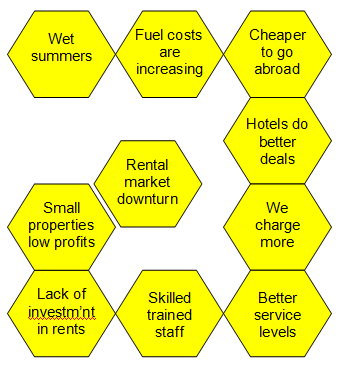The best way to understand the methodology is to work through a simple example...
A holiday cottage maintenance company is losing business. Since the reasons are unclear, they need to understand the underlying issues and investigate alternative routes to develop the business.
Step 1 - Brainstorm/Data Gather
Having clearly defined the issue we wish to address, data gather or brainstorm facts, thoughts and details. Place all the ideas associated with the issue in an unordered list. Stickies or magnetic hexagons are used to hold each "bit" of information.
Why are profits dropping?

In real life, the data gathering can produce 30 to 40 individual items of information.
Step 2 - Cluster
Take the raw unordered information and group or "cluster" the items, then give them a label. This allows us to take a step back from the detail and see the categories of information.

Step 3 - Link
With our information now clustered, link the clusters together to show the relationships and influences. This helps highlight critical areas and define our priorities.

Here, the key issue is the market situation, which has factors out-with our control. The service levels are high, but increase running costs. Is this the best way to operate given the "slack" market conditions?
This is the type of information you can draw from the model. It is not rocket science ... you probably already do this in your head. However, by using a visual approach, you can share your ideas and thinking with colleagues ... they see and understand the thinking so it is much easier for them to contribute either with their own ideas or in follow-up activities.
Step 4 - Generate New Possibilities
You can stick with the model and the priorities it describes. However, there is one further step available - use the original ideas to generate new ones.
Select two hexagons, each from a different cluster, and generate a new hexagon that describes the combination of the two.

Since hotels seem to be doing better, why not approach them, either to contract maintenance staff to their operations or, take on the contract to do all the maintenance. Repeating this approach with other hexagons will generate a range of new ideas to investigate…the limitation is only your imagination!
Summary
There are a number of benefits from using the visual thinking methodology,
- new possibilities can be developed
- structure and organisation is brought to an issue
- the subject matter is concisely overviewed
- others can easily contribute
- the head rules the heart